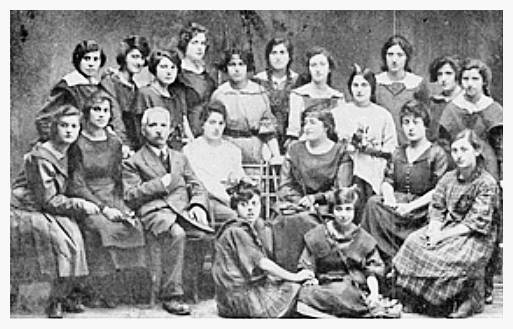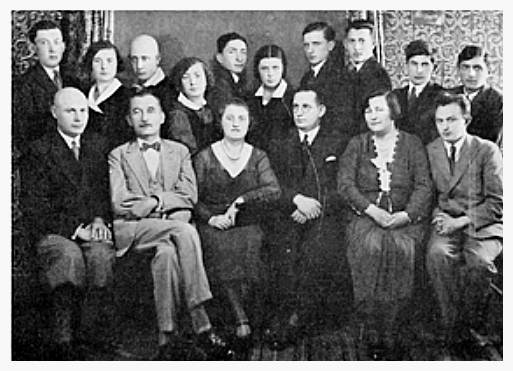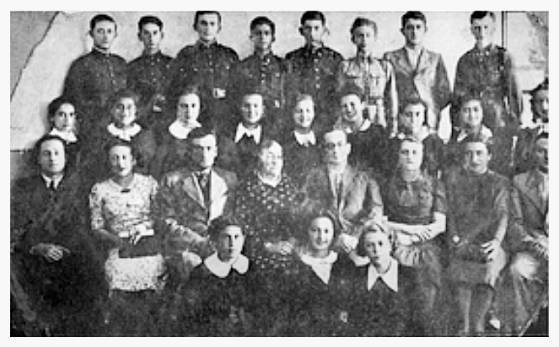by Shlomo Heftler
Translated by Hadas Eyal

Ludwika Weintraub
|
by Shlomo Heftler
Translated by Hadas Eyal

Ludwika Weintraub
Ms. Ludwika Weintraub, the owner and principle of the Jewish Secondary School,
perished in the Holocaust along with thousands of the Radomsk Jewish community.
She was born in Piotrków in 1890 and graduated from the public secondary
school there. After graduating from Geneva University in Switzerland, she
returned to Poland a few years after WWI as a certified German language teacher
and settled in Radomsk. With help from the wealthy Jews she opened the first
secondary school in town for boys and girls. The school was initially housed in
the Blumshtein house on 8 Steshelkovska Street where it had only six classes.
When it moved to the Sovinsky house on Krakovska Street eight full classes were
opened. In 1933 the Weintraub school was relocated to the vacated building of
the Polish Secondary School.
Weintraub contended with enormous financial difficulties from the very start. Most of the students paid only half the tuition and some paid just the bare minimum. But Ludwika Weintraub and her teaching staff somehow overcame these obstacles. The school was superior to the two Christian secondary schools in town and praised by the Polish Education authorities for its high level of studies.
The teaching staff that stood by Ludwika Weintraub for many years and helped achieve her substantial goal of quality secondary education for Jewish youth included Dr. Prof. Yaacov Polisyuk, Dr. Prof. Elza Polisyuk, Prof. Shimon Bir, Prof. Israel Bromberg, Prof. Yosef Barbi, Ms. S. Rozencwaig, Ms. Adela Wachtel, and David Ehrlichman the Hebrew teacher who was born in Radomsk. There was also a small circle of supporters who helped in various ways.

The fifth department and secondary school teaching staff 1919/1920
Standing from the right: Rachel Rubin, the Rajkter sisters, A. Jdevski, R.
Gliksman,
S. Weinberg, R. Zaks, S. Tiger, B. Rosenboim & M. Slomintski
Second Row: G. Grosman, principle L. Weintraub, Zalcman, Altman & H. Aronwicz
Third Row: Z. Geborg, B. Luria.

Graduating students and teaching staff 1932
Standing from the Right: Y. Lichtenstein, Horowitz, Moshe Gelbard, Moshe
Hartman,
Arna Rodal, Issachar Minski, —, Opman, Dubshits, Dovjinska,
Yaakov Brotski.
Teachers: Prof. Israel Bromberg, Ms. Grosskopf, Prof. Yaacov Polisyuk
(principal),
Prof. Elza Polisyuk, Prof. Wavon, Yaakov Brotzki.

The last graduating class and teaching staff of the Jewish Secondary School 1939
by Yechezkel Grossman
Translated by Hadas Eyal
A. From all my teachers, I have learned
Reb Michael Melamed
A child not yet five years old hovered over a page of vowelized Hebrew letters
on his first day of school. Next to him sat his teacher reb Michael Melamed
holding a pointer. Suddenly, sparking colorful candies appeared on the page.
Surprised and happy, the boy looked to his teacher. His father who stood behind
him said it was an angel who throws sweets to a boy who studies
kamatz-aleph-ao, kamatz-bet-bo. Actually, the boy understood the sweets were
from his father but accepted the explanation. This is how the boy came to share
the secrets of the supreme angels on his first day of school. His soul expanded
when he met the angels on the first page of the Chumash; on the Rosh-Hashanah
shofar tekiah verses; and on the first chapter of the Book of Ezekiel. He
dreamt of them and told the stories to his mother, friends and anyone who was
willing to listen.
During the winter Michael Melamed's students sat in the Cheder and in the summer time they sat on long low benches under the trees at the edge of the fruit garden in the courtyard of the Gonshorovitz house on Częstochower Street. Reb Michael Melamed was also a medic, almost a doctor, and an overall virtuous man.
Reb Mosze Melamed (Garncarski)
Mosze Melamed on Krakower Street was a strict and orderly educator. The
children washed hands while singing together 'Modeh Ani', 'Seh-oo Yadeichem',
etc. Punishments were ranked by severity and performed in a special ceremony.
The children studied in the morning, went home for meals, and returned for more
lessons in the afternoon. During winter time when it became dark at 3:00-4:00
pm, the child would walk home with a square kerosene lantern (a
“lumetral”) buttoned to his coat.
Reb Dan Melamed
Reb Dan was the only son of Moshe Melamed. Reb Dan introduced a modern school
method in his Cheder. There were no punishments, no whippings and the work load
was lighter. Instead, he explained and illuminated, added classes on general
subjects and taught Hebrew. The children loved him and happily arrived each
morning.
[Page 249]
Reb Szlama Melamed (Judkiewicz)
Reb Mosze and reb Szlama were partners for a time, both running one school
– a child studied Chumash and Rashi with Mosze Melamed then continued
Gemara/Talmud and Tosafot with Szlama Melamed. They amicably separated at some
point and referred students to each other.
Reb Yekhezkel Melamed (Shmulewicz)
Reb Yekhezkel was the son-in-law of Yehoshua Melamed married to his daughter
Sara'le. He was one the sharpest Ger yeshiva students. A true G-d fearing man
but even though he was popular and accepted by the Ger Chasidim – they did
not allow him to teach their children because he was not a good teacher. After
his wife passed away leaving him with three children, he married Frimet the
daughter of reb Gershon Melamed. His fate was a lifetime of poverty.
Reb Icchak Silver Melamed (Rozenfarb)
Reb Icchak'l Silver as he was called, had a unique teaching method of his own
that neither the parents nor the children understood. He never explained the
texts he taught. He translated the sentences into Yiddish for the pupils to
repeat them after him and memorize by heart. Never did he engage the heart of a
child in story or aggada nor did he ever initiate conversation. The children
were forbidden to lift their heads from their books as long as he was in the
room. If he caught one of them looking at something other than the rabbi or the
book during class, he would threaten punishment from hell or would properly
spank him. Despite all this, reb Icchak'l was one of the most important Ger
Chasidim in Radomsk, loved, respected and popular as a cheerful man who spread
joy around him at holidays and events. He was also a truly G-d fearing man and
a totally dedicated Torah scholar.
There were two public secular school for Jewish children: the one named after the famous Jewish-Polish hero Berek Joselewicz on Szałkowska Street had a Jewish teaching staff. Chaim Kreindler was the principle. The other school on Stacja Street was named after the famous Polish poet Adam Mickevich. The teachers were Polish (except one who was Jewish) and the main objective was to cultivate and instill love of the Polish homeland, its history, heroes and land. I went to this school. The only Jewish subject was “Moshe's religion#148; and it was given no importance.
Once Jewish students found Eretz Israel on the world map, they discovered the state of their people among the people of the world and how the Jews were at the lowest rung compared to the Gentiles. When the teacher sat with the children and told them glorious stories of the Polish homeland, the Jewish child jealously searched for similar comparisons in the history of the Jewish people. On the magnificent May 3rd and November 11th Polish celebrations the Jewish child yearned and prayed, tears chocking his throat, that he will one day be lucky to celebrate with his own people in his own country. Despite this all, it is important to mention the faithful work of the teachers, Jewish and Polish, full of good will to educate their student to the best of their abilities.
There was only one a Jewish secondary school in town. Very few Jews studied in the three Polish general secondary schools. Jewish boys and girls were the minority even at trade secondary school. I remember a literature class in which the teacher highly praised the talents of a Polish author who translated the book of Psalms. It was odd to hear such appreciation of the translation and learning it through memory of the original text which belongs to us.
Religious studies were for the Christians. I remember how a teacher once declared at the beginning of religion class: “those of the commercial religion out”. The Jewish students left automatically except one who remained seated. To the teacher's question he responded: “there is no such thing as a commercial religion”. The teacher repeated the instruction with a style change: “those of Moshe's religion out!”. The student stood and left.

Berek Joselewicz public secular school teachers
Seated from right to left: Mrs. Tenenboim, C. Kreindler (Principle), Mrs. Bogdanska

The Public-Government School for Jewish Children (the teachers – Polish)
Only the three numbered children photographed here survived:
1. Halina Friz (now in Buenos Aires); 2. Genia Feigelman-Bardatch (now in the
USA);
3. Sara Gelbstein-Leon (now in Israel)
by Dr. Michael Gonshorovitz
Translated by Hadas Eyal
Commemoration of the Radomsk Jews who were brutally killed and buried in
unknown communal graves must include the people from the sport societies
“Hakoach” [the power], “Hakochav” [the star],
“HaPoel” [the laborer], and the “Bund” [General Jewish
Workers' League]. Each society organized vibrant youth activities that represented
Jewish pride, universal human ethics and national values.
HaKoach was the most vigorous. The young men who started it began to secretly exercise and organize with the goal of countering the widespread inferiority sentiments among Jewish youth. By their own devices, without any public financial assistance, the young men of HaKoach dressed in blue and white uniforms entered the sports field to compete with Polish teams.
We all remember the strong proud HaKoach members: Dudek Sandomirski, Moshe Goldberg, Konitspolski, Wolman, Fishel Heftler, Moshe Pashrovski and others. Moshe Goldberg and Dudek Sandomirski regularly represented HaKoach in the Radomsk sports events.
The golden years for HaKoach were 1930-1938. The chairman at the time was the energetic dentist and charismatic sports teacher Yosef Gil who successfully engaged the majority of the youth. Under his leadership, Mr. Gil expanded the organization adding Dr. David Winfal as co-manager and forming a committee board that included Ignaz Goldberg, Okrant, Henrich Zukerman, Laufer, Dorfman, Michael Gonshorovitz (secretary), Leib Bugaiski and others. In addition to the football section that was already active, new sections of tennis, table-tennis, athletics, volleyball and ice hockey were formed.
The entire Jewish community cheered and celebrated when the HaKoach football team won the municipal championship in the arena in Częstochowa. Our HaKoach was one the best Jewish teams in Poland and the players were famous among both Jewish and Polish sport fans. I still remember several important victories against Częstochowa “Korona” (2:1); against the Piotrków champion “Concordia” (3:1); and against the Tomaszów champion “Lech”. Our team also played against Polish premier league groups “Wisla” and “Grabarnia” from Krakow, “Polania” from Warsaw and participated in international matches against “Vac” Vienna and “HaPoel” from Israel (7:4).
Our Hakoach club was the foundation of the Radomsk municipal team and delivered a nice surprise to both the Jewish and Polish local publics with a 2:1 win over the Polish garrison-force Częstochowa team and its goalkeeper Czyk who was also the goalkeeper of the Polish national team at the time. Our best player was Pistack Kleinerman. When he served in the Polish army stationed in Częstochowa he was Czyk's team mate on the national army team. Kleinerman was also on the Polish National Second Team.
Jewish HaKoach players on the Radomsk municipal team were Max Rodel (Motek), Kleinerman (Fyetl), Lefkovich (Marik), Moshe Goldberg, Michaelov Gonshorovitz and Hertz-Hirsh (Kobel). Additional brave good HaKoach players were Haftel, Schwartz, Mendele, Lifshitz, Koziol, Shlomo Fishman, Lulu Liebe, Avraham Berliner, Yankaleh, Davidovich, Shaya Koyntski, Yosef Goldberg, Machek Rodal, Bruno Rodal, and Berish Gotlib.

The Women's HaKoach team on a three-day
course in 1934
Along with the organization committee members
Standing from the right: Ignaz Goldberg, Herschel Zukerman, Madgia Vigodski,
Kopel Bialistok, Mania Bugaiski, Zorski, —, P. Ler, Mila Goldberg,
Dorfman, Taichner.
Second row: Gliksman, Neimark, Ruma Varshavski.
Bottom row: Gliksman, Rojska Zaidman

“HaKoach” Radomsk vs. “HaPoel” Tel-Aviv September 12, 1934
Respect to the memory of the Hakoach youth and all the Jewish athletes from the other sports organizations in our town before the Shoah who did not live to continue in the liberated independent Eretz-Israel.
|
JewishGen, Inc. makes no representations regarding the accuracy of
the translation. The reader may wish to refer to the original material
for verification.
JewishGen is not responsible for inaccuracies or omissions in the original work and cannot rewrite or edit the text to correct inaccuracies and/or omissions.
Our mission is to produce a translation of the original work and we cannot verify the accuracy of statements or alter facts cited.
 Radomsko, Poland
Radomsko, Poland
 Yizkor Book Project
Yizkor Book Project
 JewishGen Home Page
JewishGen Home Page
Copyright © 1999-2025 by JewishGen, Inc.
Updated 16 Nov 2025 by LA